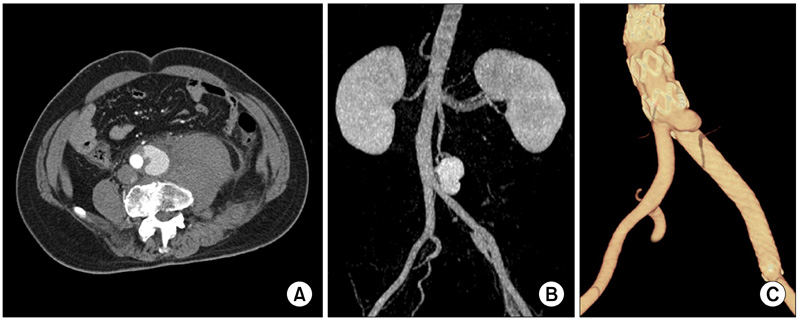J Korean Surg Soc.
2012 Apr;82(4):261-265. 10.4174/jkss.2012.82.4.261.
Spontaneous aortic rupture in a patient with neurofibromatosis type 1
- Affiliations
-
- 1Division of Vascular Surgery, Department of Surgery, Samsung Medical Center, Sungkyunkwan University School of Medicine, Seoul, Korea. ywkim@skku.edu
- 2Department of Interventional Radiology, Samsung Medical Center, Sungkyunkwan University School of Medicine, Seoul, Korea.
- 3Department of Pathology, Samsung Medical Center, Sungkyunkwan University School of Medicine, Seoul, Korea.
- KMID: 1820076
- DOI: http://doi.org/10.4174/jkss.2012.82.4.261
Abstract
- Neurofibromatosis type I (NF-1) is a rare autosomal dominant genetic disorder occurring in 1 in 3,000 individuals. Vasculopathy is a rarely reported finding in patients with NF-1. Here, we report a case of recurrent aortic pseudoaneurysm after endovascular aneurysm repair in a 49-year-old male patient with NF-1. On the sixth postoperative day following a successful open surgical repair of an aortic pseudoaneurysm, he developed hemoperitoneum due to a delayed rupture of the mesenteric artery branch. This was treated with endovascular coil embolization. We report the clinical features and histologic findings of this rare vascular disorder with a review of the relevant literature.
Keyword
MeSH Terms
Figure
Reference
-
1. Friedman JM, Arbiser J, Epstein JA, Gutmann DH, Huot SJ, Lin AE, et al. Cardiovascular disease in neurofibromatosis 1: report of the NF1 Cardiovascular Task Force. Genet Med. 2002. 4:105–111.2. National Institutes of Health Consensus Development Conference Statement: neurofibromatosis. Bethesda, Md., USA, July 13-15, 1987. Neurofibromatosis. 1988. 1:172–178.3. Shimizu T, Yamazaki Y, Tomoe H, Nishino S, Toma H, Shibata T, et al. Giant retroperitoneal hematoma in a patient with von Recklinghausen's disease. Nihon Hinyokika Gakkai Zasshi. 1998. 89:846–849.4. Chew DK, Muto PM, Gordon JK, Straceski AJ, Donaldson MC. Spontaneous aortic dissection and rupture in a patient with neurofibromatosis. J Vasc Surg. 2001. 34:364–366.5. Hines GL, Lefkowitz L, Mohtashemi M. Infrarenal aortic rupture secondary to neurofibromatosis. Ann Vasc Surg. 2002. 16:784–786.6. Falcone JL, Go MR, Baril DT, Oakley GJ, Makaroun MS, Chaer RA. Vascular wall invasion in neurofibromatosis-induced aortic rupture. Vasc Endovascular Surg. 2010. 44:52–55.7. Salyer WR, Salyer DC. The vascular lesions of neurofibromatosis. Angiology. 1974. 25:510–519.8. Saitoh S, Matsuda S. Aneurysm of the major vessels in neurofibromatosis. Arch Orthop Trauma Surg. 1998. 117:110–113.9. Nonaka D, Chiriboga L, Rubin BP. Differential expression of S100 protein subtypes in malignant melanoma, and benign and malignant peripheral nerve sheath tumors. J Cutan Pathol. 2008. 35:1014–1019.10. Wolf R, Ruzicka T, Yuspa SH. Novel S100A7 (psoriasin)/S100A15 (koebnerisin) subfamily: highly homologous but distinct in regulation and function. Amino Acids. 2011. 41:789–796.
- Full Text Links
- Actions
-
Cited
- CITED
-
- Close
- Share
- Similar articles
-
- Spontaneous Hemothorax Caused by Rupture of an Intercostal Artery Aneurysm in Neurofibromatosis Type I I : A Case Report
- Lethal Hemomediastinum due to Spontaneous Rupture of an Aberrant Bronchial Artery in a Patient with Neurofibromatosis Type 1: Successful Treatment with Embolization
- Spontaneous Hemothorax in a Patient with Type I Neurofibromatosis
- Spontaneous Massive Hemothorax in a Patient with Neurofibromatosis Type 1 with Successful Transarterial Embolization
- A Case of Spontaneous Hemothorax Due to Rupture of Pseudoaneurysm in Type 1 Neurofibromatosis




